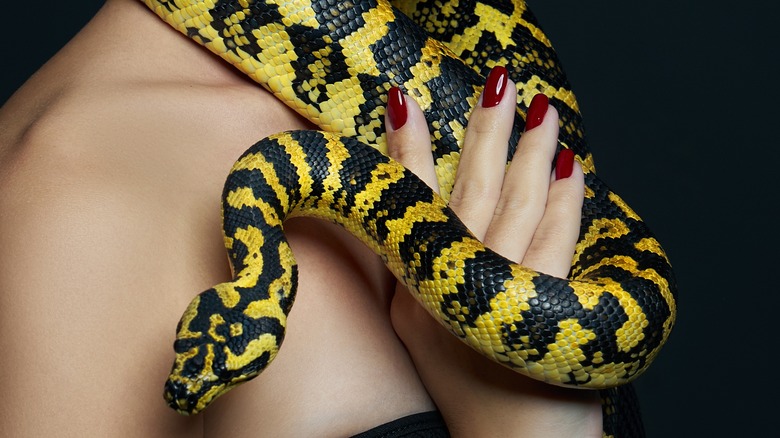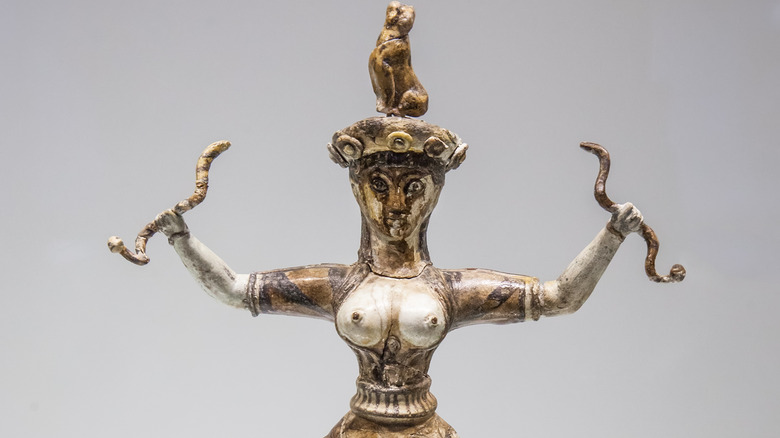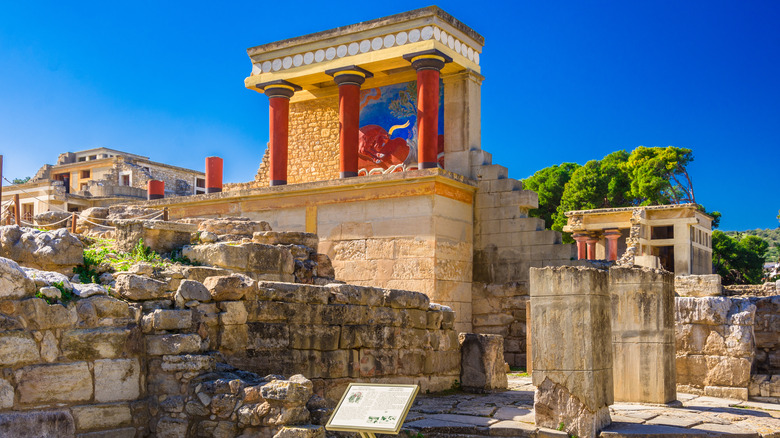The Controversial Restoration Of The Snake Goddess Of Minoan Greece
Snakes, for some reason or another, have always held a prominent place in myths and religions the world over. Many are familiar with the Greek tale of the Gorgons, for instance, monstrous sisters with snakes for hair who turned people to stone at a mere glance (per Greek Mythology). Shiva, one of Hinduism's prime deities, is often depicted with the King of Snakes, Vasuki, coiled around his neck (per Rudrashka Ratna). Buddhist lore talks of a great cobra-like Naga, Phaya Moot-cha-lin, who spread its hood to shield the Buddha from wind and rain (per St. Andrews International School, Bangkok). There's plenty of snakes in the Bible, too, even aside from the Adam and Eve story, like when Moses' staff turns into a serpent in front of Ramses II (per Bible Gateway).
But even among such tales, the Minoan Snake Goddess stands out, in large part because we know next to nothing about its significance, identity, role in Minoan culture — nothing — aside from its appearance. Found by Sir Arthur Evans in 1903 during an excavation of the palace of Knossos on the island of Crete, the Snake Goddess is made of faience, a kind of delicate pottery glazed in tin. As the Brooklyn Museum continues, Evans restored two such statues to their current, whole states. As he worked, he started making declarations about the statues, calling them "Mother Goddesses," "Priestesses," and the like, without any hard evidence. And now, some folks question Evans' work and claims.
A goddess unlike any other
As the story goes, Sir Arthur Evans found the Snake Goddesses in pieces. One of them — the one with her arms out to the side (shown above) — was missing her head and part of her right arm, as Khan Academy relates. Along with statues of snakes and birds, similar humanoid statues had been found in shrines around the palace at Knossos. Those, however, were all made of simple clay, and dubbed "Goddess with upraised arms" because nothing more could be said of them, as Brooklyn Museum explains. They were also far more simplified than the ones that Evans restored.
Even to the layperson's eye, the Snake Goddesses are odd, unique pieces. They're 34.2 and 29.5 centimeters tall (13.5 and 11.6 inches, respectively), and depict young women with long, black hair and bare breasts, layered and decorative skirts, and some kind of geometrically-designed waistbands. The one with her arms outstretched is wearing a hat or crown with — wait for it — a cat sitting on top. That goddess is gripping a flailing snake in either hand, while the other one has a snake coiling up each arm like armbands.
The problem is that there's no similar depictions of women in any other Bronze Age culture, particularly the snake-wrangling and the cat and the hat. The notion of it being a priestess, let alone a "Snake Goddess" as Evans said, is largely conjecture. Some think that Evans just wanted to make a big find.
A lost history and people
It makes sense to assume that if the Minoans went through the trouble of making loads of these "Goddess with upraised arms" statues, they must have religious or cultural significance. This is especially true of Sir Arthur Evans' reconstructed pair of delicate, hard-to-craft faience statues, and especially because all such statues were found in shrines as well as common folks' residences. The problem with their reconstruction lies in how Evans, along with Danish artist Halvor Bagge, rebuilt not only them, but their myth in one single blow.
The Minoans settled on the Greek island of Crete about 7000 BCE from modern-day Turkey and the Middle East during the Neolithic era (via the BBC). Their civilization developed and flourished for a stunningly long amount of time, all the way to about 1450 BCE, when a tsunami from the eruption of a volcano on Thera (modern-day Santorini Island) all but wiped them out (via World History Encyclopedia). They traded extensively with ancient Egypt, might have inspired the Atlantis myth, and had a huge influence on Greek culture, particularly tales of the Minotaur and King Minos (via National Geographic).
The only problem? The Minoans were largely illiterate. They had no writing system aside from a partial script, Linear A, which remains undeciphered. They also weren't big on record keeping in any form. In fact, we don't even know what they called themselves. This is why Evans' conclusions about the Snake Goddess statues are leaps more than anything else.


